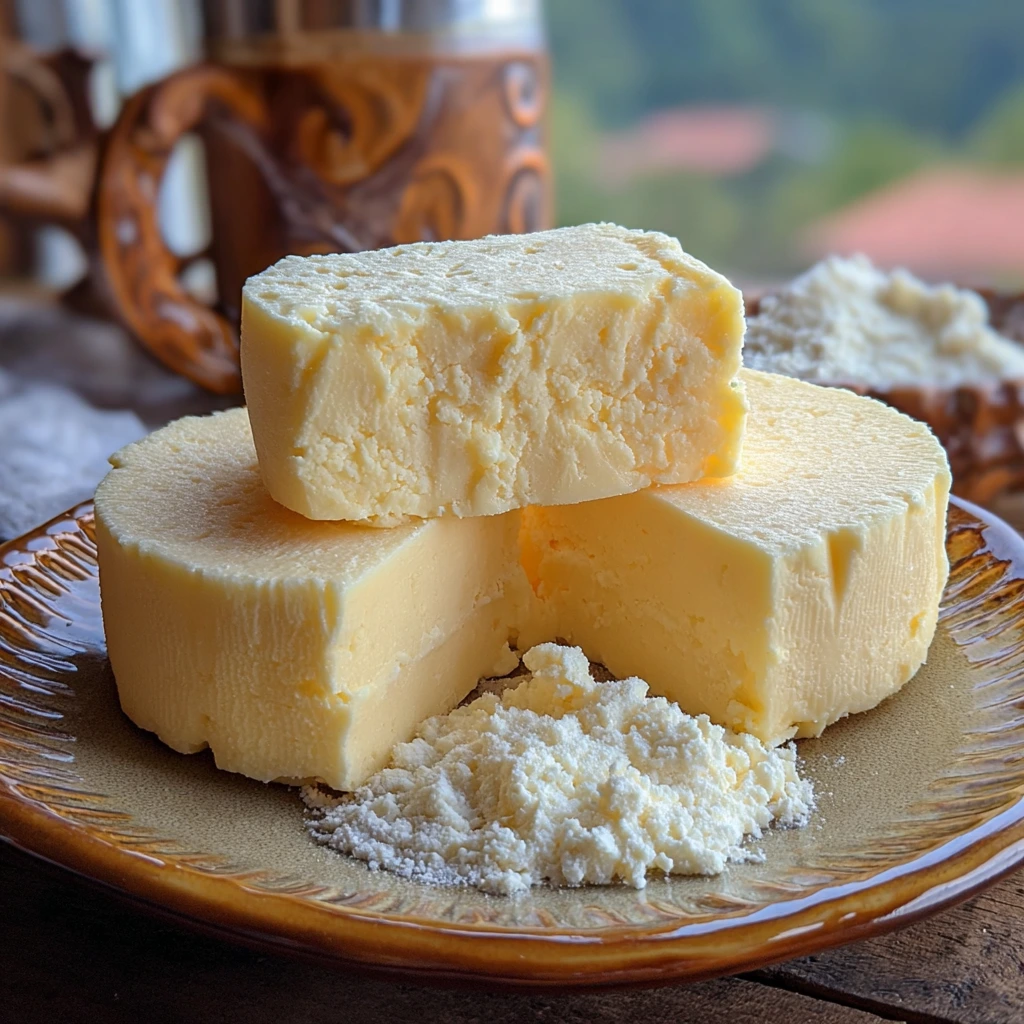There’s something deeply satisfying about making your own cheese — watching milk transform, step by step, into something rich, firm, and flavorful. Farmhouse Cheddar is one of those timeless recipes that connects us to the way food was made generations ago. No shortcuts, no machines — just patience, care, and the simple magic of fermentation.
When I first made cheddar at home, I was both nervous and fascinated. It felt like an experiment and a craft at the same time. The waiting — that slow aging process — taught me something about the value of time in cooking. The moment I sliced into my first wheel of golden, crumbly cheddar, I finally understood why cheesemaking is often called a form of art.
Why You’ll Love This Recipe
This traditional Farmhouse Cheddar has a rustic charm that’s impossible to replicate with store-bought cheese. It’s firm, slightly crumbly, and packed with that deep, tangy flavor that defines a true cheddar. It’s the kind of cheese that gets better the longer you age it — complex, nutty, and perfectly balanced.
If you love slow food, this recipe will be your next favorite project. It’s not difficult — it just requires attention and a little patience. And the reward? A homemade cheese you can grate over soups, melt into casseroles, or simply enjoy with crusty bread and a drizzle of honey.
Tip: Cheesemaking is as much about intuition as it is about technique. Learn to read the texture and smell of the curds — they’ll guide you more accurately than any timer.
Ingredients
- 2 gallons milk (preferably raw)
- ½ tsp liquid rennet (diluted)
- 1 tbsp cheese salt (or canning salt)
- ½ tsp calcium chloride (optional, for pasteurized milk)
- 1 cup cultured buttermilk (optional, for pasteurized milk)
Ingredient Notes:
- Raw milk gives the best flavor and texture, but if you’re using pasteurized milk, add calcium chloride and buttermilk to restore its structure and bacterial balance.
- Rennet helps form the curd — too much can make the cheese rubbery, so measure carefully.
- Cheese salt is non-iodized and pure — iodized salt interferes with the bacterial activity and can give off-flavors during aging.
Tip: Always use non-chlorinated water when diluting rennet — chlorine can weaken its strength.
Step-by-Step Instructions
- Warm the Milk
Pour your milk into a large stainless-steel pot and slowly heat it to 85–90°F (29–32°C), stirring gently. The goal is to warm it evenly without scalding. Personal Note: The first time I made cheddar, I heated it too quickly, and the milk curdled unevenly. Slow and steady is key — cheesemaking rewards patience. - Add Rennet and Cultures
Dilute the rennet in ¼ cup of cool, non-chlorinated water. Stir it into the warm milk using a slow figure-eight motion for about a minute.
If using pasteurized milk, add the cultured buttermilk and calcium chloride now. Tip: Once the rennet is mixed in, stop stirring — you need stillness for the curd to set properly. - Form the Curd
Let the milk rest undisturbed for 90 minutes. During this time, the curd will form — a delicate gel-like mass that separates from the whey.
You’ll know it’s ready when you can press a clean knife into it and the cut holds its shape with clear whey pooling in the gap. - Cut the Curd
Using a long knife, cut the curd into 1-inch cubes, making sure to reach the bottom of the pot. Cutting helps release the whey, which is essential for firm cheese. Tip: Try to keep the cubes uniform. Uneven curds lead to inconsistent texture later. - Rest and Heat
Let the curds rest for 60–90 minutes, then begin slowly heating them to 100°F (38°C). Raise the temperature no more than 2°F every 5 minutes, stirring gently to keep the curds separate. This slow heating process — known as “cooking the curd” — firms them up and encourages moisture to drain. - Drain the Whey
Once the curds are firm enough to hold their shape, pour off the whey through cheesecloth. Save the whey if you like — it’s great for baking, soups, or feeding livestock. - Salt the Curds
Sprinkle the cheese salt evenly over the curds, gently breaking them apart with your hands or a spoon to mix it in thoroughly. This helps draw out more whey and enhances the flavor. Tip: Salt not only seasons the cheese but also helps preserve it during aging — don’t skip this step or rush it. - Press the Cheese
Line a cheese press with fresh cheesecloth, fill it with the salted curds, and fold the cloth neatly over the top. Start pressing with light pressure, then gradually increase over two hours. After that, leave it under steady pressure for 12 hours. Flip the cheese, rewrap it, and press again for another 12 hours. Advice: Gradual pressure gives the curds time to knit together smoothly, creating a firm but not dry texture. - Aging (The Waiting Game)
Remove the cheese from the press and transfer it to a salted shelf or aging board. Let it age for at least 60 days, flipping it every day or two.
The flavor deepens with time — after two months, it’s mild and creamy; after six, it’s sharper and full-bodied. Tip: Ideal aging temperature is around 55°F (13°C) with moderate humidity. A small wine fridge or cool basement can work perfectly.
Serving and Enjoyment
After aging, your Farmhouse Cheddar will have a firm, sliceable texture and a rich, tangy aroma. It’s perfect for grating over warm soups, baking into pies, or pairing with crusty bread and fruit.
For a true farmhouse experience, serve it with homemade apple chutney or rustic bread — the kind of pairing that feels timeless and comforting.
Personal Favorite: I like slicing a piece straight from the wheel, slightly cold from the cellar, and eating it with a drizzle of honey. The salty-sweet balance is unforgettable.
Storage
Wrap the aged cheese in wax paper or cheese paper (never plastic wrap) to let it breathe. Store it in a cool, slightly humid place. Once cut, refrigerate it but always let it come to room temperature before serving — that’s when its flavor truly shines.
A Few Words from Experience
Cheesemaking taught me patience like few other kitchen crafts. Every step — from stirring the milk to waiting months for the cheese to mature — reminds me that good food takes time. There’s no instant gratification here, and that’s exactly why it’s special.
You’re not just making cheddar; you’re reviving a piece of tradition. Each wheel you age tells a story — of your hands, your kitchen, your care. And when you finally cut into it, that first taste feels like an achievement worth every hour.
Final Thoughts
This 18th-century Farmhouse Cheddar is a beautiful way to reconnect with the roots of real food. It’s rich, flavorful, and deeply rewarding — the kind of recipe that gives you pride with every bite.
So gather your ingredients, clear your countertop, and set aside some time. Cheesemaking is slower, yes, but it’s also timeless. The result? A cheese that’s yours in every sense — handmade, heartfelt, and absolutely delicious.

